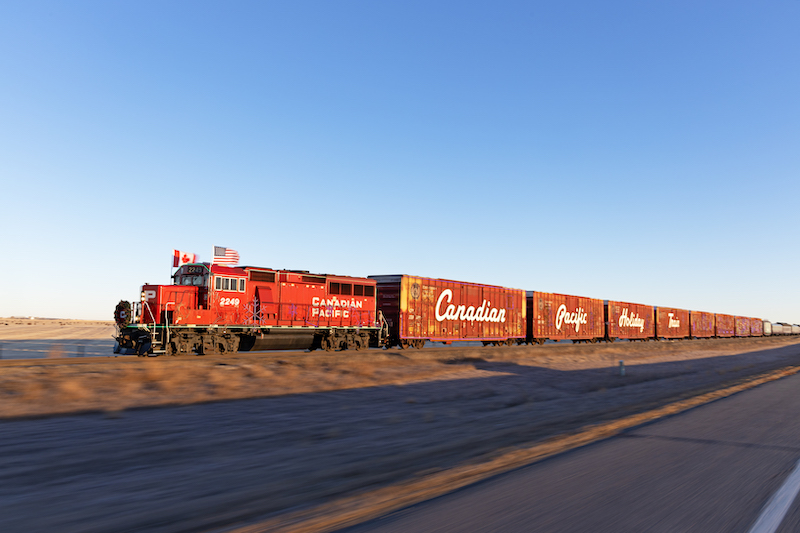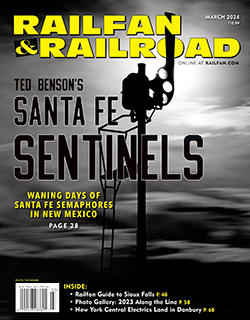By Justin Franz
Every year, the Canadian Pacific Holiday Train (now called the CPKC Holiday Train, although it still looks an awful lot like a CP train to me) tours the U.S. and Canada with a literal trainload of holiday cheer — specifically, 13 railcars covered in lights with musical performances out of an old newsprint boxcar. In December, I headed north of the border to photograph the train as it made a rare visit to Crowsnest Pass and the Kootenay Mountains. The train only visits this part of the system every other year; because of the pandemic it last visited the Crowsnest and Cranbrook subdivisions way back in 2019.
I’ve found chasing the Holiday Train provides a great opportunity to stretch a bunch of different photographic muscles. Besides having a unique train running along a scenic piece of railroad through the mountains of Alberta and British Columbia, there is also a series of concerts that attract big crowds, allowing you to capture images otherwise not available during a regular day trackside. This year’s chase also brought about a trainload of thoughts that could probably fill a couple of Camera Bag columns, but I figured I’d share them in one.
Battling the Elements
The Holiday Train was scheduled to visit my neck of the woods during the second week of December, which was a good excuse to get ready for an entire season of winter railroad photography. Some people don’t like to railfan in the snow (in fact, founding editor Jim Boyd had some choice words about those of us who love winter), but I think it’s one of the best times of year to be trackside; the light is better, winter storms can add a dose of drama to your work, and a snowy landscape can provide some incredible settings for photos. But it also takes a little extra work to prepare for a winter railfan trip.
This time of year, I usually like to bring along snowshoes and a shovel. The snowshoes are great for getting into photo locations that might have taken just your own two feet during the rest of the year. The shovel is good for digging your car out of a snowbank — although one time while railfanning I was forced to use the snowshoes to dig out the car. They weren’t as effective as the shovel, but did work. On this trip, however, neither the snowshoes nor the shovel would get much use, as there was only a dusting of snow on the ground in some places. But it was cold, which is why I packed hand and toe warmers — not for me so much, but for my gear. Batteries lose their effectiveness in cold weather, so this time of year I have hand warmers with me to keep my batteries as warm as possible when working outside. You can do this by either keeping a chemical hand warmer in the pocket where you’re storing spare batteries, or by taping it to the bottom of your camera where the battery is. And when things get really chilly, it’s nice to throw a pair of hand warmers in your gloves. Speaking of gloves, I like to use fingerless gloves when railfanning in winter. I have a few pairs, but the most effective is a pair of nylon ones where the tops of the index finger and thumb flap down. This gives you a lot more control over your camera while keeping (at least part of) your hands warm.
Humbled in Lethbridge
My friend Ryan Ellis and I headed to Lethbridge, Alta., on the afternoon of December 11, because I wanted to take a crack at photographing the train as it backed into downtown across the impressive viaduct over the Oldman River. The train was due after sunset, but I figured there would be just enough ambient light from downtown to nab the shot thanks to the high ISO powers of a modern digital camera. Plus, I had heard that on occasion they stop right on the trestle. And even if they didn’t come to a complete stop, I figured they’d be crawling over the bridge because it was a backup move. Ryan and I got to our spot early and I framed up my shot, making sure everything was in focus. I expected when the train appeared, I would take some test shots of the rear, adjust the ISO up or down as needed, and be ready for the money shot of the locomotive on the west end.
Well, needless to say, it didn’t go as planned.
First off, the backup move was going a bit faster than I had anticipated. And while I quickly adjusted the ISO to 12,800 to get a faster shutter speed, I just as quickly put it back down to a more “reasonable” 6400 because in my mind there was just no way I could realistically shoot that high. “There will be too much noise!” I thought. Moments later, the train was too far away and I was left with blurry and dark shots.
Thankfully, I had another crack at the shot I wanted about an hour later when the train returned to overnight at Kipp Yard west of town. This time, I did push the ISO as high as I could to get as much light as possible with the lens I was using (a zoom, although I really should have been using a prime lens with a lower ƒ-stop). I was able to get a few acceptable shots but upon closer inspection, felt there was still too much noise for my taste. Sure, it’s something I could fix with some effort in Photoshop, but I try not to dabble in such dark arts.
That said, some people did get good shots of the train on the bridge — specifically those set up toward the middle (it’s nearly a mile long) where the train stopped for a few minutes. As I drowned my sorrows afterward in a beer and poutine at the Telegraph Taphouse (named because at one time it was CP’s telegraph office), I decided that next time the train comes to town, I’ll try to set up closer toward the middle and hope it stops again.
Plan Ahead, Then Adjust
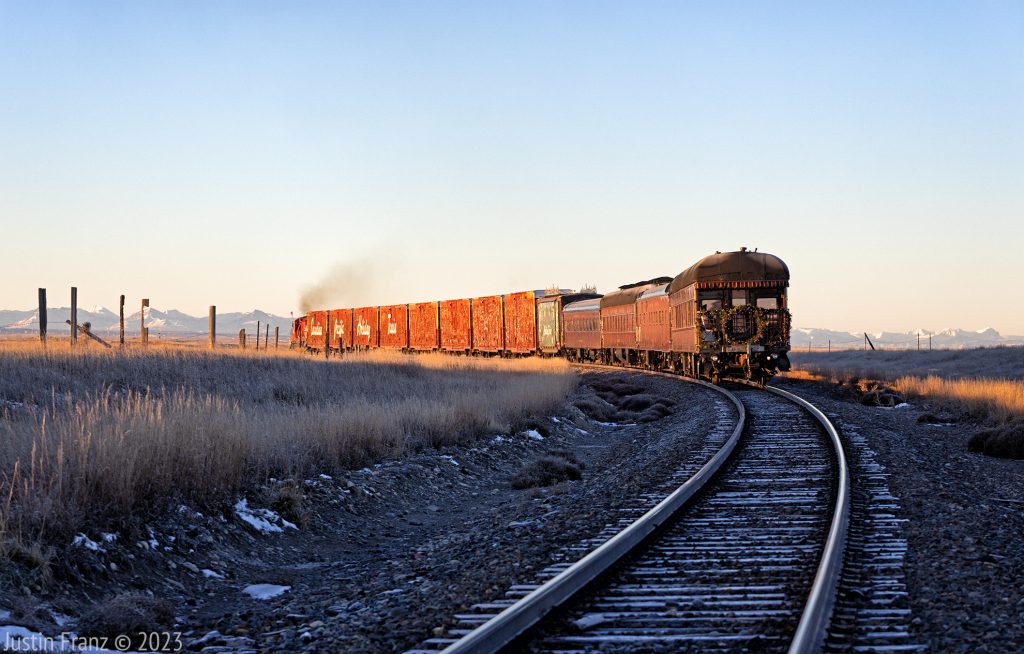
One of Associate Editor Justin Franz’s favorite shots of the trip was this view of the Holiday Train heading west toward the mountains near Monarch, Alta. The frosty ties and slight exhaust helped create a nice scene.
The beer the night before washed away any frustration from the bridge shot, and we were up bright and early on December 12 for a great day trackside on the Crowsnest and Cranbrook subdivisions. This day was a good study in having a plan and then adjusting when it isn’t possible or when new opportunities arise. The night before while sitting at the bar, I had scoped out a shot on Google Earth of the trestle near Monarch. While it’s possible to shoot the bridge from a public road right off the highway, it looked as if there was another road that would take you directly to the west end for a closer view. I thought that would be the best option as we motored west before sunrise and the train’s 7:15am call time. But upon arrival, I found something you couldn’t see on Google Earth — a gate. While the gate was unlocked, and I briefly entertained the idea of opening it and asking for forgiveness later, we decided to turn around to the crossing just west of there. And I’m glad we did, because while I had initially been thinking only about the shot of the head end, the going away shot was even better with an old fence, frosty ties, the observation car, and the mountains far off in the distance. A little bit of exhaust from the GP20C-ECO as it throttled west helped make it one of my favorite shots of the trip. Sometimes the backup plan is just as good as the original.
After nabbing that shot, we got back on the main road to try and get ahead of the train before its first stop at Fort Macleod. As we overtook the train along Highway 3, I realized a great pacing shot opportunity was emerging. Unfortunately, I was driving. So I punched the gas a little more, got a quarter mile farther down the road, pulled over, and told Ryan to switch with me; Ryan was mostly interested in seeing the train and not shooting it, so he had no qualms about the switch. As we both got back in the car, the train caught back up with us and Ryan started driving, making sure to match the train’s speed. Thankfully, we were on a four-lane highway, so this move wasn’t going to disrupt traffic too much. It’s another example of seeing opportunity and taking it when you can.
The Human Side of Things
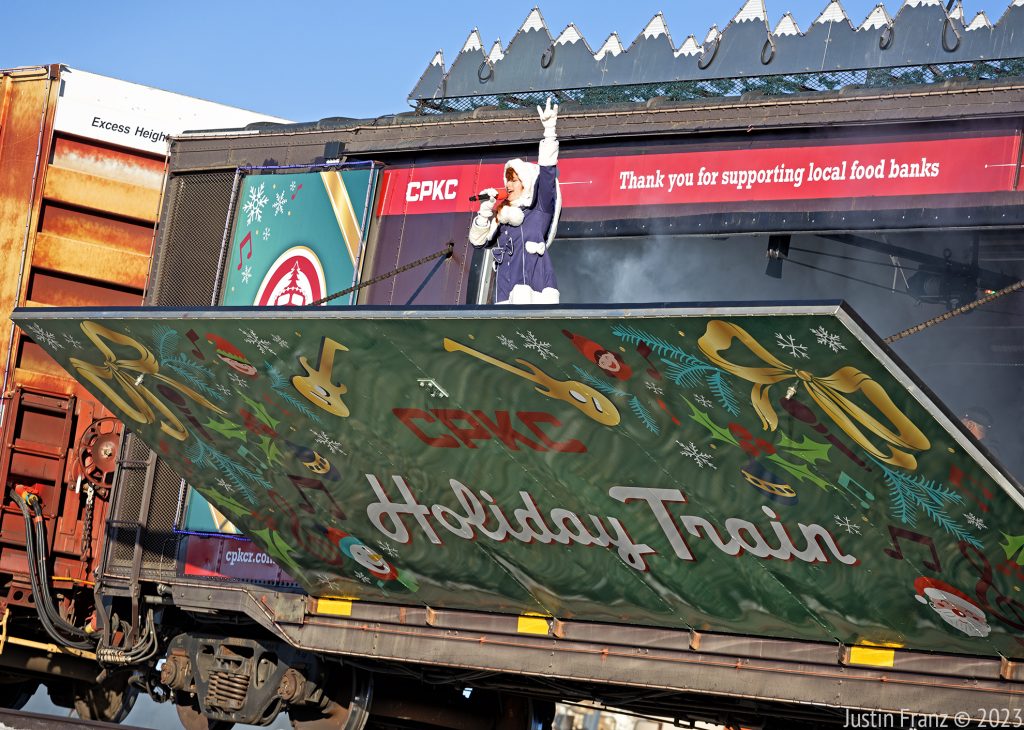
Singer and songwriter Kiesza performs at Pincher Creek, Alta. Photos of the community events are just as important as those of the train itself and help tell a more complete story.
Fort Macleod was the first of seven shows that day, and it offered a great opportunity to get some images that would stand in contrast to the traditional trackside views. Upon arrival at each town, the train usually pulls up to a public crossing or area with ample public access and then, after five or 10 minutes of setup (while playing pleasant holiday music to entertain the crowd), the stage door drops and the show gets underway. This year’s train featured performances from Kiesza and Tyler Shaw. Besides photos of the show itself, the crowds provided a great opportunity to add a few human-interest shots to the pile that day. That seems especially important when photographing something like the Holiday Train; if you were shooting a coal train, getting a photo of it with the reason it exists — the coal mine or power plant — would be key. In this case, getting photos of the train and the communities interacting with it is also key. Events such as this provide great opportunities for candid, unstaged photos.
That first show at Fort Macleod also gave me a good opportunity to get an idea for the pace of the rest of the shows; by the time we got to Pincher Creek, I had figured out the setlist and order of events, so when I saw the big check for the local food bank come out, I knew it was time to head for the car and get back on the road to get ahead of the train.
Fernie Finale
Ryan and I finished off our day with the Holiday Train in Fernie, B.C. The little ski town produced one of the biggest crowds of the day and photo opportunities were everywhere. Because it was also getting dark, I was able to get a few good shots of the train all lit up. A pet peeve of mine is seeing people photograph the Holiday Train using flashes; the flash will almost always blow out the lights, robbing the train of one of its key elements. The last shot of the day was of the train departing Fernie as townspeople pulled out their phones to capture the moment.
Overall, it was a great day trackside and one that produced a wide variety of images. Far too often on railfan trips, I find that I come home with a lot of images that look the same (train in landscape). Something like the Holiday Train provides a great opportunity to change things up with a little human interest.
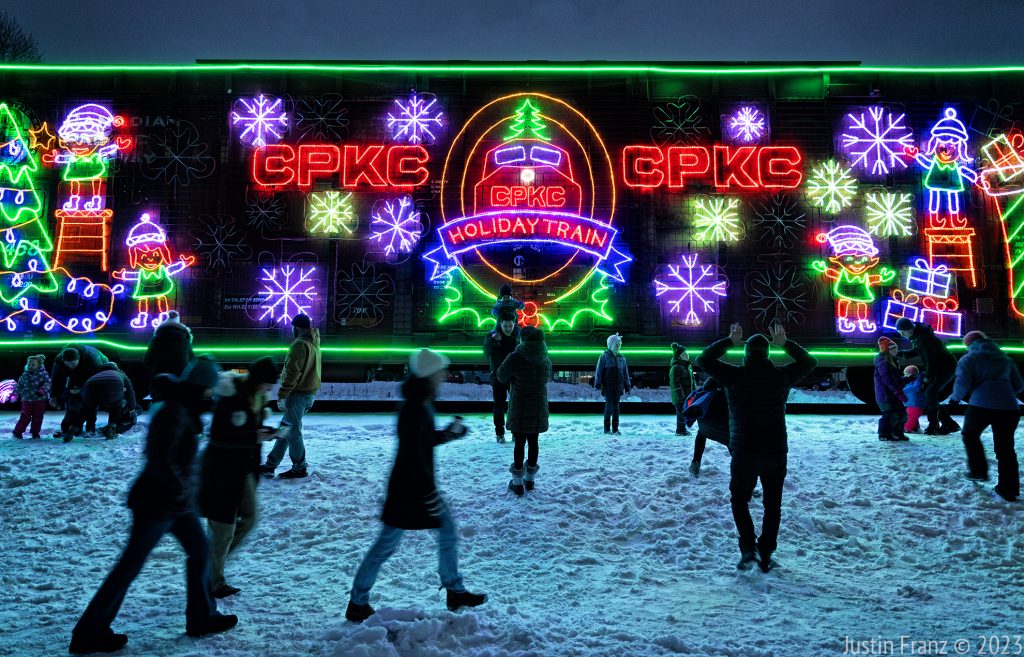
People are a huge part of photographing the CPKC Holiday Train, as are the lights! At Fernie, B.C., thousands of townspeople came out to see the train as it made its first visit to the community since 2019. While the train looked a lot like it had four years earlier, there were a few signs that something had changed and CP was now CPKC.


